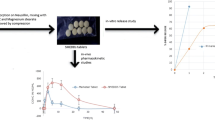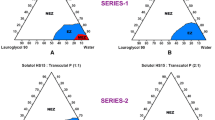Abstract
Silymarin has been used to treat hepatobiliary diseases. However, it has a low bioavailability after being administered orally on account of its low solubility in water. In order to improve the dissolution rate, silymarin was formulated in the form of a self-microemulsifying drug delivery system (SMEDDS). The optimum formulation of SMEDDS containing silymarin was obtained based on the study of pseudo-ternary phase diagram. The SMEDDS consisted of 15% silymarin, 10% glyceryl monooleate as the oil phase, a mixture of polysorbate 20 and HCO-50 (1:1) as the surfactant, Transcutol as the cosurfactant with a surfactant/cosurfactant ratio of 1. The mean droplet size of the oil phase in the microemulsion formed from the SMEDDS was 67 nm. The % release of silybin from the SMEDDS after 6 hours was 2.5 times higher than that from the reference capsule. After its oral administration to rats, the bioavailability of the drug from the SMEDDS was 3.6 times higher than the reference capsule.
Similar content being viewed by others
References
Arcari, M., Brambilla, A., Brandt, A., Caponi, R., Corsi, G., and Di Rella, M., A new inclusion complex of silibinin and β-cyclodextrins:in vitro dissolution kinetics andin vivo absorption in comparison with traditionl formulations.Boll Chim. Farm., 131, 205–209 (1992).
Attwood, D. and Florence, A. T., Surfactant Systems: Their Chemistry, Pharmacy and Biology. Chapman and Hall, New York, pp. 236–237 (1983).
Attwood, D., Microemulsion. Kreuter, J. (Ed.), Colloidal Drug Delivery Systems, Marcel Dekker, New York, pp. 31–65 (1994).
Barzaghi, N., Crema, F., Gatti, G., Pifferi, G., and Perucca, E., Pharmacokinetic studies on IdB 1016, a silybin-phosphaidyl-choline complex, in healthy human subjects.Eur. J. Drug Metab. Pharmacokinet, 15, 333–338 (1990).
Basaga, H., Poli, G., Tekkaya, C., and Aras, I., Free radical scavenging and antioxidative properties of “silibin” complexs on microsomal lipid peroxidation.Cell Biochem. Funct., 15, 27–33 (1997).
Chen, W., Xia, H., and Wu, W., Optimized preparation of silymarin dripping pills by a central composite design-response surface method.Chin. Trad. Herb. Drug, 36, 679–683 (2005).
Chi, S. C., Enhanced dissolution rate of biphenyl dimethyl dicarboxylate using SMEDDS.B.T. Gattefosse, 92, 75–80 (1999).
Constantinides, P. P. and Scalart, J. P., Formulation and physical characterization of water-in-oil microemulsions containing long- versus medium-chain glycerides.Int. J. Pharm., 158, 57–68 (1997).
Dewick, P. M., Medicinal Natural Products, John Wiley & Sons, New York, pp. 138–140 (1997).
Fitnleman, V., Mordern phytotherapy and its use in Gastrointestinal Conditions, Planta Med., 57, Supplement Issue 1, S50 (1991).
Flora, K., Hahn, M., Rosen, H., and Benner, K., Milk thistle(Silybum marianum) for the therapy of liver disease.Am. J. Gastroenterol., 93, 139–143 (1998).
Gasco, M. R., Microemulsions in the pharmaceutical field: perspectives and applications. In: C. Solans, H. Kunieda, eds. Industrial applications of Microemulsions. New York: Marcel Dekker, pp. 97–122 (1997).
Gattefosse, Formulation guide, Microemulsions. 9,1 (1994).
Gažák, R., Svobodová, A., Psotová, J., Sedmerá, P., Prikrylová, V., Walterová, and D., Krn, V., Oxidised derivatives of silybin and their antiradical and antioxidant activity.Bioorg. Med. Chem., 12, 5677–5687 (2004).
Georgakopoulos, E., Farah, N., and Vergnault, G., Oral anhydrous nonionic microemulsions administrated in softgel capsules.Gattefosse, B.T., 85, 11–20 (1992/93).
Gibaldi, M. and Perrier, D., One compartment model. In: Pharmacokinetics, 2nd Ed., Ed : Swarbrick, J., Dekker, M., New York, pp. 1–43 (1982).
Humberstone, A. J. and Charman, W. N., Lipid-based vehicles for the oral delivery of poorly water soluble drugs.Adv. Drug Deliv. Rev., 25, 103–128 (1997).
Kang, B. K., Lee, J. S., Chon, S. K., Jeong, S. Y., Yuk, S. H., Khang, G., Lee, H. B., and Cho, S. H., Development of self-microemulsifying drug delivery systems (SMEDDS) for oral bioavailability enhancement of simvastatin in beagle dogs.Int. J. Pharm., 21 A, 65–73 (2004).
Kim, C. K. and Park, J. S., Solubility enhancers for oral drug delivery: can chemical structure manipulation be avoided?Am. J. Drug Deliv., 2, 113–130 (2004).
Kim, H. J., Yoon, K. A., Hahn, M. K., Park, E. S., and Chi, S. C., Preparation and In vitro evaluation of self-microemulsifying drug delivery systems containing idebenon.Drug Develop. Ind. Pharm., 26, 523–529 (2000).
Koo, C. H., Compositions and preparations of silymarin complex with the improved bioavailability. WO 02/069962 (2002).
Kvasnicka, R, Biba, B., Sevcik, R., Voldrich, M., and Kratka, J., Analysis of the active components of silymarin.J. Chromatogr. A., 990, 239–245 (2003).
Lawrence, M. J. and Rees, G. D., Microemulsion-based media as novel drug delivery systems.Adv. Drug Deliv. Rev., 45, 89–121 (2000).
Lorenz, D., Lucker, P. W., Mennicke, W. H., and Wetzelsberger, N., Pharmacokinetics studies with silymarin in human serum and bile.Meth. And Find. Exptl. Clin. Pharmacol., 6, 665–661 (1984).
Mayer, D., Surfactant Science and Technology. VCH Publishers, Inc., pp. 174–175(1988).
Morazzoni, P., Magistretti, M. J., Giachetti, C., and Zanolo, G., Comparative bioavailability of silipide, a new flavanolignan complex, in rats.Eur. J. Drug Metab. Pharmacokinet., 17, 39–44 (1992).
Morazzoni, P., Montalbetti, A., Malandrino, S., and Pifferi, G., Comparative pharmacokinetics of silipide and silymarin in rats.Eur. J. Drug Metab. Pharmacokinet, 18, 289–297 (1993).
Morazzoni, P. and Bombardelli, E., Silybum marianum(carduus mahanus). Fitoterapia, 66, 3–42 (1995).
Ni, N., Sanghvi, T., and Yalkowsky, S. H., Solubilization and preformulation of carbendazim.Int. J. Pharm., 244, 99–104 (2002).
Pouton, C. W., Formulation of self-emulsifying drug delivery systems.Adv. Drug Deliv Rev, 25, 47–58 (1997).
Rickling, B., Hans, B., Kramarczyk, R., Krumbiegel, G., and Weyhenmeyer, R., Two high-performance liquid chromato-graphic assays for the determination of free and total silibinin diastereomers in plasma using column switching with electrochemical detection and reversed-phase chromatography with ultraviolet detection.J. Chromatogr. B., 670, 267–277 (1995).
Schandalik, R. and Perucca, E., Pharmacokinetics of silybin following oral administration of silipide in patients with extrahepatic biliary obstruction.Drugs Explt. Clin. Res., XX, 37–42 (1994).
Schulman, J. H., Stoekenius, W., and Prince, L. M. J., Mechanism of formation and structure of microemulsions by electron microscopy.Phys. Chem., 63, 1677–1678 (1959).
Schulz, H. U., Schurer, M., Krumbiegel, G., Watcher, W., Weyhenmeyer, R., and Seidel, G., The solubility and bioequi-valence of silymarin preparations.Arzneimittelforschung, 45, 61–64 (1995).
Shah, N. H., Carvajal, M. T, Patel, C. I., Infeld, M. H., and Malick, A. W., Self-emulsifying drug delivery system (SEDDS) with polyglycolysed glycerides for improvingin vitro dissolution and oral absorption of lipophilic drugs.Int. J. Pharm., 106, 15–23 (1994).
Sinko, P. J., Martin’s Physical Pharmacy and Pharmaceutical Sciences, Lippincott Williams & Wilkins, pp. 509–519 (2006).
Skottova, N., Kreeman, V, Vaoa, P., Chmela, Z., Ulrichova, J., and Simanek, V., Effect of silymarin and silibinin-phosphati-dylcholine complex on plasma and lipoprotein cholesterol, and oxidation of LDL in rats fed on high cholesterol diet supplemented with current oil. Acta Univ. Palacki Olomuc. Fac. Med., 144, 55–58 (2000).
Tarr, B. D. and Yalkowsky, S. H., Enhanced intestinal absorption of cyclosporine in rats through the reduction of emulsion droplet size.Pharm. Res., 6, 40 (1989).
Torrado, S., Lopez, M.L., Torrado, G, Bol’as, F., Torrado, S., and Cad’omiga, R., A novel formulation of albendazole solution: oral bioavailability and efficacy evaluation.Int. J. Pharm., 156, 181–187 (1997).
Author information
Authors and Affiliations
Corresponding author
Rights and permissions
About this article
Cite this article
Woo, J.S., Kim, TS., Park, JH. et al. Formulation and biopharmaceutical evaluation of silymarin using SMEDDS. Arch Pharm Res 30, 82–89 (2007). https://doi.org/10.1007/BF02977782
Received:
Issue Date:
DOI: https://doi.org/10.1007/BF02977782




